Industrial furnaces are also included in heat-resistant steel
The service temperature of gray cast iron is generally below 300 C. It is used for furnace components whose tensile strength is less than 400 MPa and which do not bear impact load. From room temperature to 400 C, its mechanical properties have little change. Its tensile strength decreases slightly between 150 200 C, then rises again, and decreases significantly above 400 C. Ductile iron is generally used at temperatures below 370 C for furnace components requiring higher strength and fatigue limit and bearing a certain impact load. The main requirement for heat-resistant cast iron is heat resistance, i.e. oxidation resistance, growth resistance, high strength, hardness and creep resistance at high temperature, with emphasis on oxidation resistance and growth resistance. The heat-resistant temperature refers to the temperature at which the length increment of the sample is less than 0.2% and the average oxidation weight increment is less than 0.5g/(m2 h) after 150 H. When heat-resistant cast iron is used in furnace components, low chromium heat-resistant cast iron is selected for those below 550-600 C, and high silicon heat-resistant cast iron or high silicon heat-resistant nodular cast iron for those below 700-750 C. Increasing silicon content or adding molybdenum can further increase the heat-resistant temperature. The heat resistance temperature of silicon-aluminium or high-aluminium heat-resistant nodular cast iron can reach 1050-1100 C.
How Does The Vacuum Sintering Furnace Work?
Vacuum Heat Treatment Furnace For Oxide Metal Powder
Supply Vacuum Brazing Furnace
Supply Vacuum Sintering Furnace




评论
发表评论